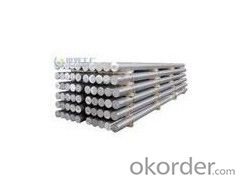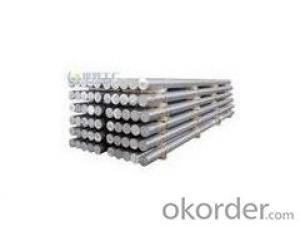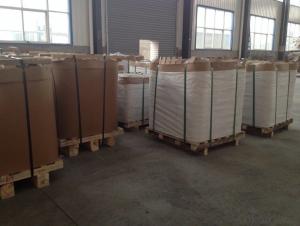Extruded Aluminum Bars for Any Use
- Loading Port:
- China Main Port
- Payment Terms:
- TT OR LC
- Min Order Qty:
- -
- Supply Capability:
- -
OKorder Service Pledge
OKorder Financial Service
You Might Also Like
Aluminium foil acts as a total barrier to light and oxygen (which cause fats to oxidise or become rancid), odours and flavours, moistness, and germs, it is used broadly in food and pharmaceutical packaging. The purpose of aluminium is to make long-life packs (aseptic processing|aseptic packaging) for drinks and dairy goods, which allows storing without refrigeration. Aluminium foil containers and trays are used to bake pies and to pack takeaway meals, ready snacks and long life pet foods.
Aluminium foil is widely sold into the consumer market, often in rolls of 500 mm (20 in) width and several metres in length.It is used for wrapping food in order to preserve it, for example, when storing leftover food in a refrigerator (where it serves the additional purpose of preventing odour exchange), when taking sandwiches on a journey, or when selling some kinds of take-away or fast food. Tex-Mex restaurants in the United States, for example, typically provide take-away burritos wrapped in aluminium foil.
Aluminium foils thicker than 25 μm (1 mil) are impermeable to oxygen and water. Foils thinner than this become slightly permeable due to minute pinholes caused by the production process.
Aluminium foil has a shiny side and a matte side. The shiny side is produced when the aluminium is rolled during the final pass. It is difficult to produce rollers with a gap fine enough to cope with the foil gauge, therefore, for the final pass, two sheets are rolled at the same time, doubling the thickness of the gauge at entry to the rollers. When the sheets are later separated, the inside surface is dull, and the outside surface is shiny. This difference in the finish has led to the perception that favouring a side has an effect when cooking. While many believe that the different properties keep heat out when wrapped with the shiny finish facing out, and keep heat in with the shiny finish facing inwards, the actual difference is imperceptible without instrumentation.The reflectivity of bright aluminium foil is 88% while dull embossed foil is about 80%.
We provide a full range of precision aluminum strip for almost any application. We produce aluminum strip in a wide variety of alloys, including clad composites. Our aluminum strip can be produced in standard dimensions or custom made to your special requirements. We produce both imperial and metric units. We manufacture in compliance with the main international specifications, and tighter tolerances or custom tempers are available upon request. We offer various surface conditions, custom finishes (painting, anodizing, embossing), special processing, and multiple packaging options to meet our customer's unique requirements. The following is a summary of our capabilities.
Manufactured in compliance with the main international specifications and standards, including: Aluminum Association, ASTM, EN, and DIN.
We can also manufacture in compliance with other international standards including:ASME, SAE, AMS, AWS, FED, MIL, QQ, ISO, BS, AFNOR, JIS and GOST.
Manufactured in compliance with the main international specifications and standards.
Tighter tolerances are available upon request.
Aluminium (or aluminum; see spelling differences) is a chemical element in the boron group with symbol Al and atomic number 13. It is a silvery white, soft, ductile metal. Aluminium is the third most abundant element (after oxygen and silicon), and the most abundant metal in the Earth's crust. It makes up about 8% by weight of the Earth's solid surface. Aluminium metal is so chemically reactive that native specimens are rare and limited to extreme reducing environments. Instead, it is found combined in over 270 different minerals.The chief ore of aluminium is bauxite.
Aluminium is remarkable for the metal's low density and for its ability to resist corrosion due to the phenomenon of passivation. Structural components made from aluminium and its alloys are vital to the aerospace industry and are important in other areas of transportation and structural materials. The most useful compounds of aluminium, at least on a weight basis, are the oxides and sulfates.
Despite its prevalence in the environment, no known form of life uses aluminium salts metabolically. In keeping with its pervasiveness, aluminium is well tolerated by plants and animals. Owing to their prevalence, potential beneficial (or otherwise) biological roles of aluminium compounds are of continuing interest.
The earliest citation given in the Oxford English Dictionary for any word used as a name for this element is alumium, which British chemist and inventor Humphry Davy employed in 1808 for the metal he was trying to isolate electrolytically from the mineral alumina. The citation is from the journal Philosophical Transactions of the Royal Society of London: "Had I been so fortunate as to have obtained more certain evidences on this subject, and to have procured the metallic substances I was in search of, I should have proposed for them the names of silicium, alumium, zirconium, and glucium."
Davy settled on aluminum by the time he published his 1812 book Chemical Philosophy: "This substance appears to contain a peculiar metal, but as yet Aluminum has not been obtained in a perfectly free state, though alloys of it with other metalline substances have been procured sufficiently distinct to indicate the probable nature of alumina."[69] But the same year, an anonymous contributor to the Quarterly Review, a British political-literary journal, in a review of Davy's book, objected to aluminum and proposed the name aluminium, "for so we shall take the liberty of writing the word, in preference to aluminum, which has a less classical sound."
The -ium suffix conformed to the precedent set in other newly discovered elements of the time: potassium, sodium, magnesium, calcium, and strontium (all of which Davy isolated himself). Nevertheless, -um spellings for elements were not unknown at the time, as for example platinum, known to Europeans since the 16th century, molybdenum, discovered in 1778, and tantalum, discovered in 1802. The -um suffix is consistent with the universal spelling alumina for the oxide (as opposed to aluminia), as lanthana is the oxide of lanthanum, and magnesia, ceria, and thoria are the oxides of magnesium, cerium, and thorium respectively.
The aluminum spelling is used in the Webster's Dictionary of 1828. In his advertising handbill for his new electrolytic method of producing the metal in 1892, Charles Martin Hall used the -um spelling, despite his constant use of the -ium spelling in all the patents[58] he filed between 1886 and 1903. It has consequently been suggested[by whom?] that the spelling reflects an easier-to-pronounce word with one fewer syllable, or that the spelling on the flyer was a mistake.[citation needed] Hall's domination of production of the metal ensured that aluminum became the standard English spelling in North America.
- Q: What's the difference between the 2024 aluminum bar and the 2A12 aluminum bar?
- If the use of pure aluminum packaging is still able to maintain the effect.Widely used in aircraft structures (skins, frames, ribs, frames, etc.) rivets, missile components, truck hubs, propeller components, and many other structures
- Q: Which of the 6061 aluminum bars, heat treated and 7075 aluminum rods, has been treated with heat?
- The hardness of aluminum alloys is directly related to the chemical composition of the alloy.
- Q: Hello! Ask, 6061, after the uniform treatment of aluminum rods, extruded out of the profile strength (hardness) will be affected?
- 6061 is a cold treatment aluminum forging products, suitable for corrosion resistance, oxidation requirements of high application. The utility model has the advantages of good usability, easy coating and good processability.
- Q: What is an aluminum rod intermediate frequency heating furnace?
- The utility model relates to an aluminum rod heating furnace for extrusion, which is suitable for heating larger diameter aluminum bars, has fast heating speed and relatively accurate temperature control.
- Q: How to refine the crystallization of cast aluminium bars
- Grain refining is one of the important processes in aluminum alloy casting and halo casting, and also one of the most effective measures to solve the casting defects such as porosity, coarse grain, bright crystal, feather crystal and crack. In the alloy casting, are non-equilibrium crystallization, all the impurities (including alloy elements) most concentrated at the grain boundaries, the smaller the grain boundary area, the greater the impurity elements (or alloy) uniformity is high. The impurity elements, high uniformity, can reduce its harmful effects, even small amounts of impurities harmful variable as beneficial; surface of alloy elements, high uniformity, can play a greater alloying elements capable of making full use of resources to achieve. The role of grain refinement, grain boundary area enlargement and element homogeneity can be explained by the following calculations. 1 and 2 metal blocks assuming the same volume of V, which is composed of cube grain, grain length of metal piece 1 for 2a, 2 of the length of a, then the metal piece 1 grain boundary area: metal piece 2 grain boundary area: metal block 2 block 1 of the grain boundary area is 2 times of metal.
- Q: In mechanical drawings, what is the technical requirement of an aluminum bar "delivery status: CS"?
- When ordering, the delivery status should be marked in the contract.Status of aluminum alloys:R: hot working stateM: annealed conditionY: work hardening stateC: quenching conditionCZ: quenching and natural agingCZY: quenching, natural aging, cold working stateCS: quenching and artificial aging conditionCSY: quenching, artificial aging, cold working stateY2: semi hard stateRCS (T5): air cooling and manual aging
- Q: I would like to know the benefits of the aluminum bar homogeneous process and some related knowledge, know the master, please let me know, thank you!
- At present our company mainly production 15 tons, 20 tons, 35 tons and 40 tons, 15 tons of available specifications, electricity, oil or gas heating, and more than 20 tons of oil or gas heating.
- Q: Aluminum rod 1060-h14 physical test standard
- GB/T 3191-2010 aluminium and aluminium alloy extruded barsThis standard specifies the general industrial aluminum and Aluminum Alloy extrusion (hereinafter referred to as the bar) test method requirements, inspection rules and signs, packaging, transportation, storage and quality certificate and contract (or order).
- Q: What's the hardness of 7075 aluminum bars?
- Tensile strength 524Mpa:0.2%Yield strength 455Mpa: elongation 11%Modulus of elasticity E/Gpa:71Hardness: 150HBDensity: 2850
- Q: Where are aluminum bars used mainly? What if the process is used?
- The amount of. The aluminum rods I touch are very big and long. Used to cut into small pieces and then heated and extruded into aluminum.
Send your message to us
Extruded Aluminum Bars for Any Use
- Loading Port:
- China Main Port
- Payment Terms:
- TT OR LC
- Min Order Qty:
- -
- Supply Capability:
- -
OKorder Service Pledge
OKorder Financial Service
Similar products
Hot products
Hot Searches
Related keywords

























